KITA
About
- Username
- KITA
- Joined
- Visits
- 127
- Last Active
- Roles
- member
- Points
- 1,479
- Badges
- 0
- Posts
- 410
Reactions
-
Alleged 'A12' benchmark for 2018 iPhone with 4GB RAM pops up
Condemning the entire SoC? Such nonsense. I'm discussing how it is known to throttle considerably under sustained loads.ericthehalfbee said:KITA said:
Argument? If that's what you see, then folly indeed. I've been only posting facts about the A11, it's ability to sustain load and its known TDP values for the large cores. I haven't suggested that "Apple needs to redesign" it's SoC. Everything is speculation based on the current facts and the apparent benchmark values we've been provided with in Appleinsider's post.
You're only posting facts?
Bullshit.
You're carefully selecting a few key tests where the A11 doesn't perform as good, and condemning the entire SoC because of it. It's why you keep linking those same tests over and over and over as if repeating yourself makes it true.
Here's a few other slides from AnandTech.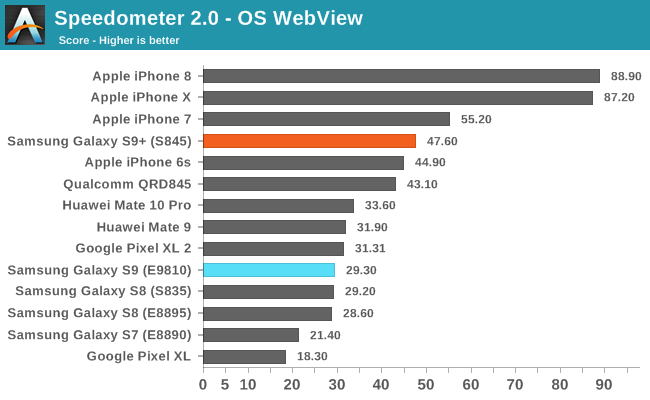
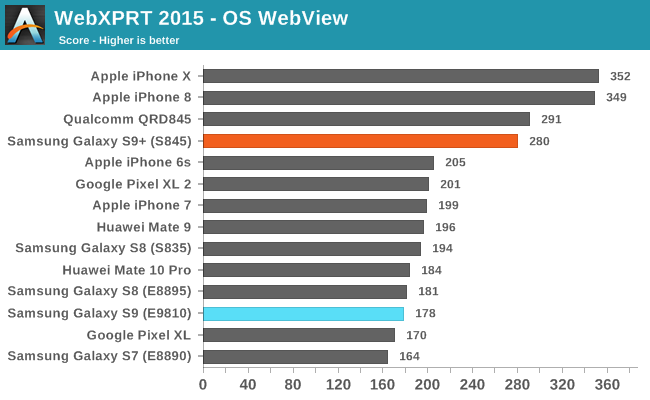
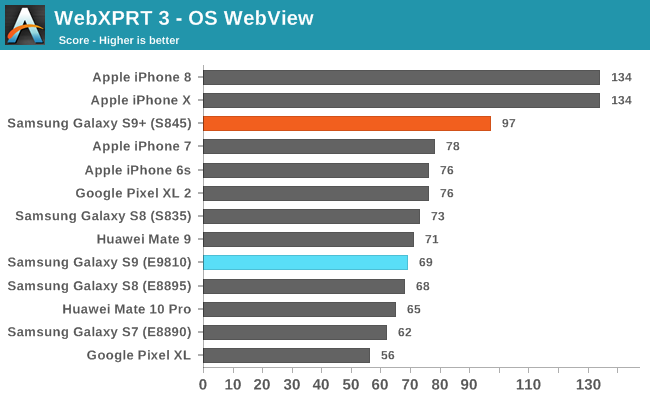
And here's a great one just for you. This shows the throttling of various devices and indeed the 835 does throttle very little. However, you're missing the point. These are smartphones, not laptops or desktops. Sustained performance isn't nearly as critical as burst performance and race-to-sleep. An A11 or 845 throttled has the same performance as an 835. An A11 or 845 running under normal circumstances will mop the floor with an 835. And this is what's really important. In the worst case scenario an A11 could slow down to the same speed as an 835. For the rest of the time it's waaaaaaaaay ahead. So you can stop with your stupid posts about throttling as if they're somehow relevant.

And one last one. This is on the S9 equipped with the 845. Not only is it throttled, but you're warned about overheating. I don't think I've ever received such a warning on an iPhone, and I benchmark/stress test mine regularly.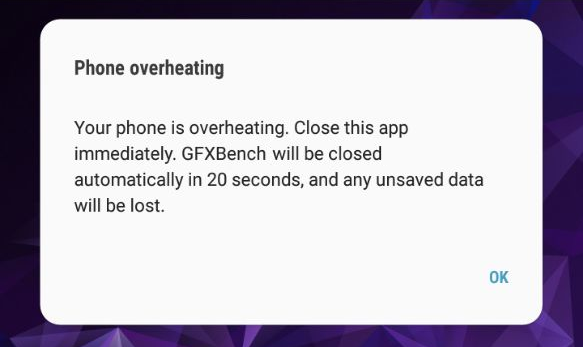
I don't know why you're showing those other tests, I'm very clearly talking about sustained performance. We're all aware of iOS + the A11's performance in web based tasks.
The Snapdragon 845 is on the same process as the Snapdragon 835. To put it simply, Qualcomm will be making major changes come Q1 2019 to their next flagship as it will be using a brand new architecture and make the move to a 7nm process. The 845, in a normal chassis, can't sustain that performance. That being said, some of the gaming oriented smartphones that use it, such as the ASUS ROG Phone or Xiaomi Black Shark, will not throttle as much. One last thing to all of this, although they haven't done yet, Anandtech will be moving onto a benchmark that can utilize Vulkan, and not just older Android APIs.
Andrei, from Anandtech, pointed out on a number of occasions some major issues with Samsung's software on the S9 (on both the Exynos and Snapdragon models). He made a couple of articles about the software, some of which has apparently been addressed in the consumer release, although I'm sure you'll never read them anyways.
Beyond gaming, or other niche tools, sustained performance is very useful for things such as AR applications. As I was saying to another user, it's necessary to move beyond the status quo and allow for new experiences to be developed.
Although I've done enough to entertain you, once again, you're just supplying useless conjecture, most of it has nothing to do with what I've been talking about.

-
Alleged 'A12' benchmark for 2018 iPhone with 4GB RAM pops up
As I've said plenty of times now, I relied on Geekbench for peak scores.tmay said:
You do know that you relied on a Geekbench score, which doesn't test for sustained performance, to support your view:KITA said:
Argument? If that's what you see, then folly indeed. I've been only posting facts about the A11, it's ability to sustain load and its known TDP values for the large cores. I haven't suggested that "Apple needs to redesign" it's SoC. Everything is speculation based on the current facts and the apparent benchmark values we've been provided with in Appleinsider's post.tmay said:
So, your argument is that Apple needs to redesign its A series to throttle less for these two sustained benchmarks?KITA said:
I everything I've been talking about is from Anandtech.tmay said:
You keep speaking of this, but you haven't actually showed this "difference between peak and sustained performance". I'm not doubting you, though I presume that you have links?KITA said:
Yes, the physics test is CPU bound, the graphics test is GPU bound. Regardless of the results compared to other SoCs, it's very easy to see the difference between peak and sustained performance on the A11.tmay said:
So, you're confident that a couple of synthetic tests of a single aspect of an SOC, the GPU, are a reliable means to predicting the performance of a SOC in general use?KITA said:
We don't have sustained performance tests for most other tests, and for the ones that we do, the A11 throttles hard.tmay said:
Okay, but what about all of the other tests that the A11 scored better than the 835?KITA said:
I was never talking about the 845.tmay said:
You took that out of context:KITA said:
That is from Anandtech.melgross said:
You should look at the reviews of phones on aRstechnica and anandtech, instead of choosing one spec, which is the one in which Apple doesn’t seem to care much about, which is physics. You need an overal test for this.KITA said:
For the iPhone X using Metal API:melgross said:
No, it did not. All chips, particularly mobile chips, throttle under load, but the A11 throttles significantly less than any competing chip.KITA said:
The A11 was known to throttle considerably under sustained load.melgross said:If true, not an impressive boost from last year, particularly since they say it’s got six cores. I hope this is off.
Geekbench 4 has pauses built in to avoid thermal throttling.
These numbers might actually be quite impressive if they're closer to the actual sustained performance of the A12.
3DMark Sling Shot 3.1 Extreme Unlimited - Physics (CPU bound):
Peak: 2523
Sustained: 1895
3DMark Sling Shot 3.1 Extreme Unlimited - Graphics (GPU bound):
Peak: 4428
Sustained: 2884
The Snapdragon 835 throttled much less than the A11.
This is also from Anandtech:The A11 is severely thermally constrained and is only able to achieve these scores when the devices are cold. Indeed as seen from the smaller score of the iPhone 8, the SoC isn’t able to sustain maximum performance for even one benchmark run before having to throttle.
- Andrei F.
"When we’re looking at competitor devices we see only the the iPhone X able to compete with the last generation Snapdragon 835 devices – however with a catch. The A11 is severely thermally constrained and is only able to achieve these scores when the devices are cold. Indeed as seen from the smaller score of the iPhone 8, the SoC isn’t able to sustain maximum performance for even one benchmark run before having to throttle. Unfortunately this also applies to current and last generation Exynos and Kirin SoCs as both shed great amount of performance after only a few minutes. I’ve addressed this issue and made a great rant about it in our review of the Kirin 970. For this reason going forward AnandTech is going to distinguish between Peak and Sustained scores across all 3D benchmarks. This however needs to be tested on commercial devices as the QRD platform isn’t a thermally representative phone for the SoC, so until that happens, we’ll have to just estimate based on power consumption where the Snapdragon 845 ends up.
This article was a preview on the Snapdragon 845, not a device test.
Show me a device with a Snapdragon 845, in production, that does better than the A11 and doesn't throttle, and I'll give you a "like".
The Snapdragon 835 does better and doesn't throttle nearly as much.
For the Pixel 2 using OpenGL ES 3.1 API:
3DMark Sling Shot 3.1 Extreme Unlimited - Physics (CPU bound):
Peak: 2907
Sustained: 2864
3DMark Sling Shot 3.1 Extreme Unlimited - Graphics (GPU bound):
Peak: 4390
Sustained: 3591
Hence, we circle back to my original post. Geekbench uses pauses to prevent thermal throttling, so all we see is the peak performance, and not the sustained performance.
Melgross was claiming that the current A12 scores in the iPhone 11,2 aren't very impressive, but contrary to that, the A12 scores might better represent sustained performance as it's on a new 7nm process. As such, it's likely a considerable improvement over the A11, an SoC that was known to throttle.
That, and we also know each one of the A11's big cores uses 3~3.5 W at load. Having all 6 cores at load (2 big and 4 small) would simply not be sustainable in an iPhone. If the A12 brought that TDP down, with potential adjustments to architecture and the move to a 7nm process, we'll likely see better sustained performance.
"If the A12 brought the TDP down":
Why would Apple want a lower TDP if for certain workloads, maximum performance, even with throttling, was the desired result? In fact, Apple specifically spoke of this at WWDC, wrt a very rapid ramp of the CPU (that's an instantaneously high TDP!) followed by a more gradual reduction in clock rate and then a shift to the low power cores. I might be incorrect on those details, but I specifically remember the slide.
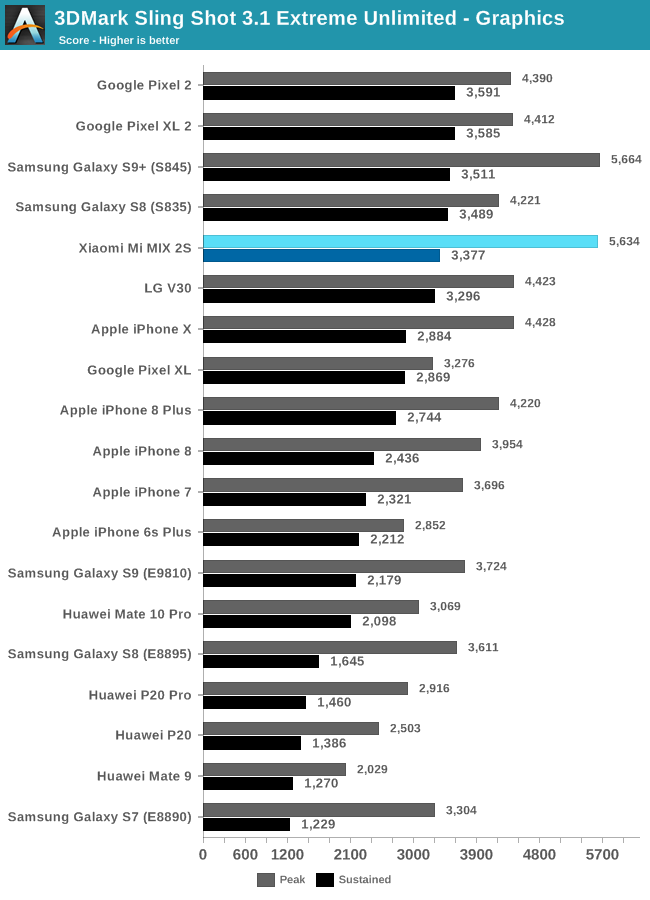
Anandtech
If these iPhone 11,2 numbers are accurate, Apple might not be pushing the peak performance this iteration and want to ensure sustained performance and efficiency take priority. It is a mobile device after all. Of course, there are still so many factors that weigh in on all of this. As was mentioned earlier, there's a lot more to a mobile SoC that just the CPU and GPU. There's the DSP, ISP, etc., and now a larger push into dedicated ML hardware (although, this can still fall under other components as was the case for Qualcomm's Hexagon DSP).
Folly, pure and simple.
"Melgross was claiming that the current A12 scores in the iPhone 11,2 aren't very impressive, but contrary to that, the A12 scores might better represent sustained performance as it's on a new 7nm process. As such, it's likely a considerable improvement over the A11, an SoC that was known to throttle."
There's everything to suggest that there will be an improvement in peak performance, but nothing to indicate that Apple will do much to reduce throttling, I'd be as likely to be correct that it will continue to be a large mismatch, as it is now, because, in most workloads, it just isn't an issue.
The iPhone 11,2 scores that we have would suggest that peak performance has hardly improved, but it does not mean that sustained performance hasn't.
Most workloads don't involve some of the new features and experiences coming to mobile. For example, using AR on an iPhone will get it to warm up pretty quickly. In order to create a better experience, sustained performance is critical. Otherwise the user would only be able to use an extensive application for short durations. This isn't just about supporting the status quo, but ensuring that the hardware will support new developments and applications.
-
Alleged 'A12' benchmark for 2018 iPhone with 4GB RAM pops up
Argument? If that's what you see, then folly indeed. I've been only posting facts about the A11, it's ability to sustain load and its known TDP values for the large cores. I haven't suggested that "Apple needs to redesign" it's SoC. Everything is speculation based on the current facts and the apparent benchmark values we've been provided with in Appleinsider's post.tmay said:
So, your argument is that Apple needs to redesign its A series to throttle less for these two sustained benchmarks?KITA said:
I everything I've been talking about is from Anandtech.tmay said:
You keep speaking of this, but you haven't actually showed this "difference between peak and sustained performance". I'm not doubting you, though I presume that you have links?KITA said:
Yes, the physics test is CPU bound, the graphics test is GPU bound. Regardless of the results compared to other SoCs, it's very easy to see the difference between peak and sustained performance on the A11.tmay said:
So, you're confident that a couple of synthetic tests of a single aspect of an SOC, the GPU, are a reliable means to predicting the performance of a SOC in general use?KITA said:
We don't have sustained performance tests for most other tests, and for the ones that we do, the A11 throttles hard.tmay said:
Okay, but what about all of the other tests that the A11 scored better than the 835?KITA said:
I was never talking about the 845.tmay said:
You took that out of context:KITA said:
That is from Anandtech.melgross said:
You should look at the reviews of phones on aRstechnica and anandtech, instead of choosing one spec, which is the one in which Apple doesn’t seem to care much about, which is physics. You need an overal test for this.KITA said:
For the iPhone X using Metal API:melgross said:
No, it did not. All chips, particularly mobile chips, throttle under load, but the A11 throttles significantly less than any competing chip.KITA said:
The A11 was known to throttle considerably under sustained load.melgross said:If true, not an impressive boost from last year, particularly since they say it’s got six cores. I hope this is off.
Geekbench 4 has pauses built in to avoid thermal throttling.
These numbers might actually be quite impressive if they're closer to the actual sustained performance of the A12.
3DMark Sling Shot 3.1 Extreme Unlimited - Physics (CPU bound):
Peak: 2523
Sustained: 1895
3DMark Sling Shot 3.1 Extreme Unlimited - Graphics (GPU bound):
Peak: 4428
Sustained: 2884
The Snapdragon 835 throttled much less than the A11.
This is also from Anandtech:The A11 is severely thermally constrained and is only able to achieve these scores when the devices are cold. Indeed as seen from the smaller score of the iPhone 8, the SoC isn’t able to sustain maximum performance for even one benchmark run before having to throttle.
- Andrei F.
"When we’re looking at competitor devices we see only the the iPhone X able to compete with the last generation Snapdragon 835 devices – however with a catch. The A11 is severely thermally constrained and is only able to achieve these scores when the devices are cold. Indeed as seen from the smaller score of the iPhone 8, the SoC isn’t able to sustain maximum performance for even one benchmark run before having to throttle. Unfortunately this also applies to current and last generation Exynos and Kirin SoCs as both shed great amount of performance after only a few minutes. I’ve addressed this issue and made a great rant about it in our review of the Kirin 970. For this reason going forward AnandTech is going to distinguish between Peak and Sustained scores across all 3D benchmarks. This however needs to be tested on commercial devices as the QRD platform isn’t a thermally representative phone for the SoC, so until that happens, we’ll have to just estimate based on power consumption where the Snapdragon 845 ends up.
This article was a preview on the Snapdragon 845, not a device test.
Show me a device with a Snapdragon 845, in production, that does better than the A11 and doesn't throttle, and I'll give you a "like".
The Snapdragon 835 does better and doesn't throttle nearly as much.
For the Pixel 2 using OpenGL ES 3.1 API:
3DMark Sling Shot 3.1 Extreme Unlimited - Physics (CPU bound):
Peak: 2907
Sustained: 2864
3DMark Sling Shot 3.1 Extreme Unlimited - Graphics (GPU bound):
Peak: 4390
Sustained: 3591
Hence, we circle back to my original post. Geekbench uses pauses to prevent thermal throttling, so all we see is the peak performance, and not the sustained performance.
Melgross was claiming that the current A12 scores in the iPhone 11,2 aren't very impressive, but contrary to that, the A12 scores might better represent sustained performance as it's on a new 7nm process. As such, it's likely a considerable improvement over the A11, an SoC that was known to throttle.
That, and we also know each one of the A11's big cores uses 3~3.5 W at load. Having all 6 cores at load (2 big and 4 small) would simply not be sustainable in an iPhone. If the A12 brought that TDP down, with potential adjustments to architecture and the move to a 7nm process, we'll likely see better sustained performance.
"If the A12 brought the TDP down":
Why would Apple want a lower TDP if for certain workloads, maximum performance, even with throttling, was the desired result? In fact, Apple specifically spoke of this at WWDC, wrt a very rapid ramp of the CPU (that's an instantaneously high TDP!) followed by a more gradual reduction in clock rate and then a shift to the low power cores. I might be incorrect on those details, but I specifically remember the slide.

Anandtech
If these iPhone 11,2 numbers are accurate, Apple might not be pushing the peak performance this iteration and want to ensure sustained performance and efficiency take priority. It is a mobile device after all. Of course, there are still so many factors that weigh in on all of this. As was mentioned earlier, there's a lot more to a mobile SoC that just the CPU and GPU. There's the DSP, ISP, etc., and now a larger push into dedicated ML hardware (although, this can still fall under other components as was the case for Qualcomm's Hexagon DSP).
Folly, pure and simple.

-
Dell reverses course, going public in $21.7B proposal
That's not an ugly bulky computer.macxpress said:
Like David said...all they make is ugly computers that aren't special or unique. Thanks for proving his point. And don't tell me thats plastic on the top portion of the palm rest.KITA said:
Right up until they don'tdavidmalcolm said:Dell typically makes ugly bulky computers that aren't unique or special in any way shape or form.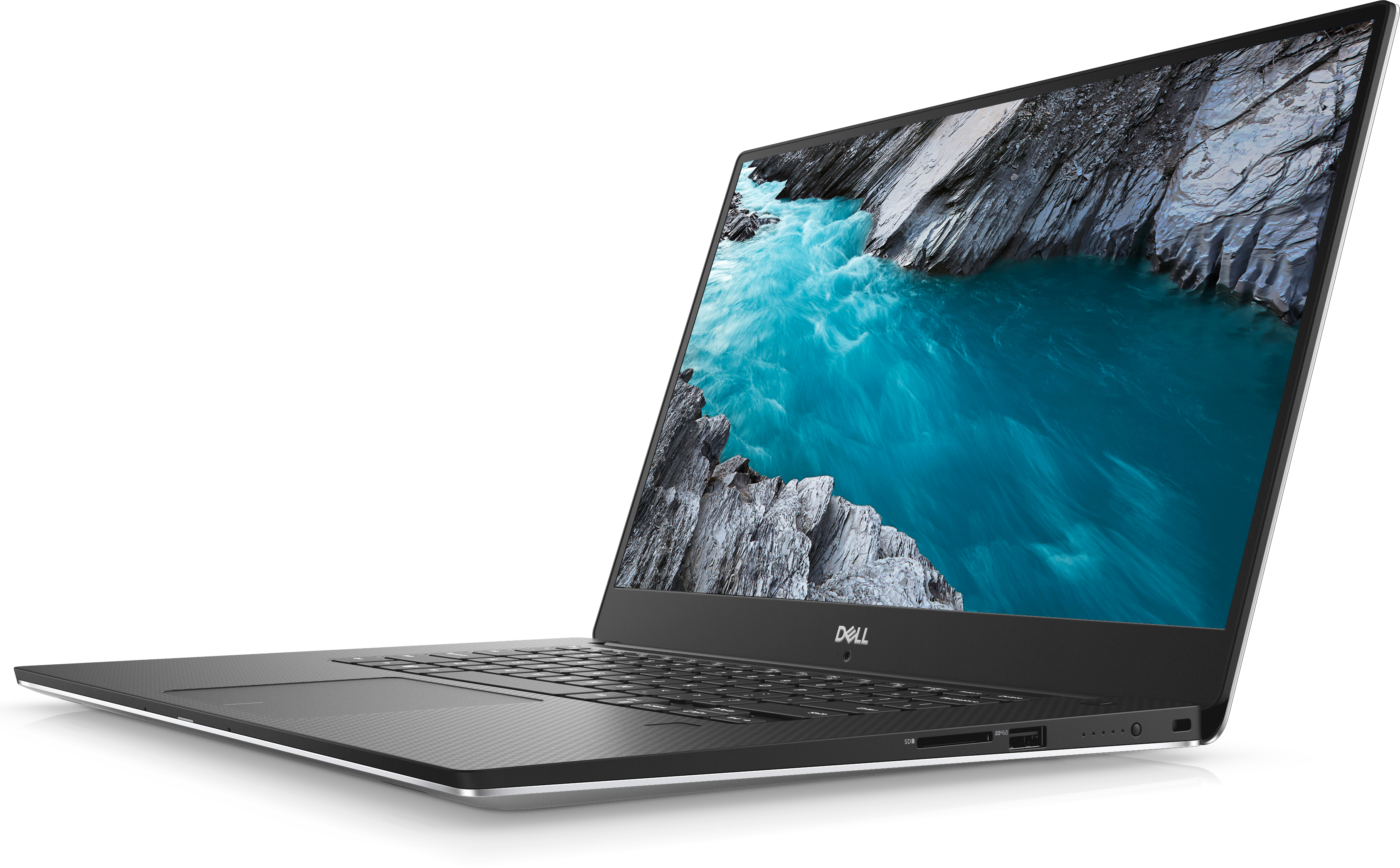
The body is made of aluminum and carbon fiber.
It houses a 6-core i9-8950HK, GTX 1050Ti 4 GB, 32 GB DDR4, 1 TB PCIe SSD, fingerprint sensor, 97 Wh battery and has a low bezel 4K 400 nit IPS display with >100% Adobe RGB. In terms of ports it has a USB-C Thunderbolt 3, USB-A, HDMI 2.0, and an SD card slot. All of that in a 4.5 lbs package.
It's definitely a unique computer. The XPS 15 in general has been well reviewed over the past few years.
-
Alleged 'A12' benchmark for 2018 iPhone with 4GB RAM pops up
We don't have sustained performance tests for most other tests, and for the ones that we do, the A11 throttles hard.tmay said:
Okay, but what about all of the other tests that the A11 scored better than the 835?KITA said:
I was never talking about the 845.tmay said:
You took that out of context:KITA said:
That is from Anandtech.melgross said:
You should look at the reviews of phones on aRstechnica and anandtech, instead of choosing one spec, which is the one in which Apple doesn’t seem to care much about, which is physics. You need an overal test for this.KITA said:
For the iPhone X using Metal API:melgross said:
No, it did not. All chips, particularly mobile chips, throttle under load, but the A11 throttles significantly less than any competing chip.KITA said:
The A11 was known to throttle considerably under sustained load.melgross said:If true, not an impressive boost from last year, particularly since they say it’s got six cores. I hope this is off.
Geekbench 4 has pauses built in to avoid thermal throttling.
These numbers might actually be quite impressive if they're closer to the actual sustained performance of the A12.
3DMark Sling Shot 3.1 Extreme Unlimited - Physics (CPU bound):
Peak: 2523
Sustained: 1895
3DMark Sling Shot 3.1 Extreme Unlimited - Graphics (GPU bound):
Peak: 4428
Sustained: 2884
The Snapdragon 835 throttled much less than the A11.
This is also from Anandtech:The A11 is severely thermally constrained and is only able to achieve these scores when the devices are cold. Indeed as seen from the smaller score of the iPhone 8, the SoC isn’t able to sustain maximum performance for even one benchmark run before having to throttle.
- Andrei F.
"When we’re looking at competitor devices we see only the the iPhone X able to compete with the last generation Snapdragon 835 devices – however with a catch. The A11 is severely thermally constrained and is only able to achieve these scores when the devices are cold. Indeed as seen from the smaller score of the iPhone 8, the SoC isn’t able to sustain maximum performance for even one benchmark run before having to throttle. Unfortunately this also applies to current and last generation Exynos and Kirin SoCs as both shed great amount of performance after only a few minutes. I’ve addressed this issue and made a great rant about it in our review of the Kirin 970. For this reason going forward AnandTech is going to distinguish between Peak and Sustained scores across all 3D benchmarks. This however needs to be tested on commercial devices as the QRD platform isn’t a thermally representative phone for the SoC, so until that happens, we’ll have to just estimate based on power consumption where the Snapdragon 845 ends up.
This article was a preview on the Snapdragon 845, not a device test.
Show me a device with a Snapdragon 845, in production, that does better than the A11 and doesn't throttle, and I'll give you a "like".
The Snapdragon 835 does better and doesn't throttle nearly as much.
For the Pixel 2 using OpenGL ES 3.1 API:
3DMark Sling Shot 3.1 Extreme Unlimited - Physics (CPU bound):
Peak: 2907
Sustained: 2864
3DMark Sling Shot 3.1 Extreme Unlimited - Graphics (GPU bound):
Peak: 4390
Sustained: 3591
Hence, we circle back to my original post. Geekbench uses pauses to prevent thermal throttling, so all we see is the peak performance, and not the sustained performance.
Melgross was claiming that the current A12 scores in the iPhone 11,2 aren't very impressive, but contrary to that, the A12 scores might better represent sustained performance as it's on a new 7nm process. As such, it's likely a considerable improvement over the A11, an SoC that was known to throttle.